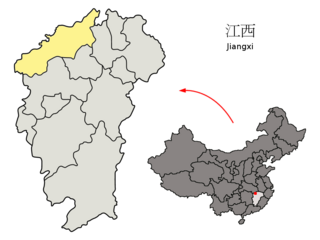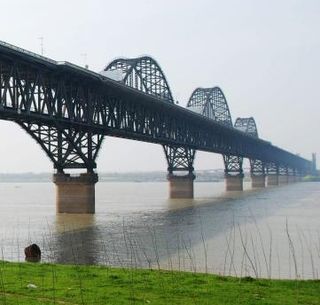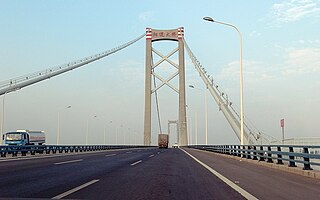
The Yangtze, Yangzi, or officially Chang Jiang is the longest river in Asia, the third-longest in the world and the longest in the world to flow entirely within one country. It rises at Jari Hill in the Tanggula Mountains and flows 6,300 km (3,900 mi) in a generally easterly direction to the East China Sea. It is the seventh-largest river by discharge volume in the world. Its drainage basin comprises one-fifth of the land area of China, and is home to nearly one-third of the country's population.

Hubei is a landlocked province of the People's Republic of China, and is part of the Central China region. The name of the province means "north of the lake", referring to its position north of Dongting Lake. The provincial capital, Wuhan, serves as a major transportation hub and the political, cultural, and economic hub of central China.

Jiujiang, formerly transliterated Kiukiang or Kew Keang, is a prefecture-level city located on the southern shores of the Yangtze River in northwest Jiangxi Province, People's Republic of China. It is the second-largest prefecture-level city in Jiangxi province. Jiujiang literally means "nine rivers".

Yichang, alternatively romanized as Ichang, is a prefecture-level city located in western Hubei province, China. It is the third largest city in the province after the capital, Wuhan and the prefecture-level city Xiangyang, by urban population. The Three Gorges Dam is located within its administrative area, in Yiling District. As of the 2020 census, its population was 4,017,607 inhabitants of whom 1,536,012 lived in the built-up area consisting of Yiling, Xiling, Wujiagang and Dianjun urban districts. The Xiaoting District has not yet been urbanized.

Huanggang is a prefecture-level city in easternmost Hubei Province, China. It is situated to the north of the middle reaches of the Yangtze River and is bounded in the north by the Dabie Mountains and is named after Mount Huanggang. It borders Henan in the north, Anhui in the east and Jiangxi in the south.

Ezhou is a prefecture-level city in eastern Hubei Province, China. As of the 2020 census, the city had a population of 1,079,353, of which 695,697 lived in the core Echeng District. The Ezhou - Huanggang built-up area was home to 1,152,559 inhabitants made of the Echeng and Huangzhou, Huanggang Districts.

Huangshi, alternatively romanized as Hwangshih, is a prefecture-level city in southeastern Hubei province, People's Republic of China. Its population was 2,469,079 inhabitants at the 2020 census; 1,567,108 of whom lived in the built-up area made up of 4 urban districts plus the city of Daye, now being part of the agglomeration.

The Yichang Yangtze River Highway Bridge is a suspension bridge that crosses the Yangtze River some 20 km downstream from the center city of Yichang, China. It is located within the prefecture-level city of Yichang, and carries the G50 Shanghai–Chongqing Expressway.

The Jiujiang Yangtze River Bridge is a combined road-rail bridge over the Yangtze River near the city of Jiujiang, Jiangxi Province in eastern China. It links Xunyang District of Jiujiang, south of the river, with Xiaochi Town in Huangmei County, Hubei Province, to the north. The central section of the bridge uses a combined arch and truss structure and the bridge is one of the longest continuous truss bridges in the world, with a longest span of 216 meters (709 ft) and a total truss length of 1,314 meters (4,311 ft) =3x162+180+216+180+2x126. The double deck bridge carries four vehicular lanes and two sidewalks on the top deck and two railway tracks on the bottom deck.

The Wuhan Yangtze Great Bridge, commonly known as Wuhan First Yangtze Bridge, is a double-deck road and rail bridge across the Yangtze River in Wuhan, in Central China. At its completion in 1957, the bridge was the easternmost crossing of the Yangtze, and was often referred to as the "First Bridge of the Yangtze".

The bridges and tunnels across the Yangtze River carry rail and road traffic across China's longest and largest river and form a vital part of the country's transportation infrastructure. The river bisects China proper from west to east, and every major north-south bound highway and railway must cross the Yangtze. Large urban centers along the river such as Chongqing, Wuhan, and Nanjing also have urban mass transit rail lines crossing the Yangtze.

Hankou–Yichang railway, or Hanyi railway, is a 291-kilometre (181 mi) long high-speed railway between Hankou and Yichang in Hubei province, China. The railway forms a section of the Huhanrong passenger-dedicated line from Shanghai to Wuhan to Chengdu. The Hanyi Railway was completed in spring 2012 and started commercial operations on July 1, 2012. Adjacent high-speed rail sections, the Hefei–Wuhan railway to the east and the Yichang−Wanzhou railway to the west, opened respectively in April 2009 and December 2010.

The Yichang–Wanzhou railway, or the Yiwan railway connects the cities of Yichang and Wanzhou via Lichuan, Hubei. It was completed in 2010 and forms part of the Shanghai–Wuhan–Chengdu passenger railway. Out of the line's total 377 km (234 mi) length, 288 km (179 mi) runs on bridges or in tunnels. According to the chief engineer, Zhang Mei, the line was the most difficult ever constructed in China. Operation started on 22 December 2010.

The Yangluo Yangtze River Bridge is a suspension bridge over the Yangtze River in Wuhan, Hubei, China. With a main span of 1,280 metres (4,200 ft), at its opening it was tied with the Golden Gate Bridge as the ninth longest suspension bridge in the world. The bridge carries the G70 Fuzhou–Yinchuan Expressway and G4201 Wuhan Ring Expressway over the Yangtze River and provides easy access to both sides of the river as part of a larger plan to promote development in the eastern portion of the city. Construction on the bridge began on November 4, 2003, and it opened to traffic on December 26, 2007.

Nanjing–Tongling railway or Ningtong railway, is a single-track railroad in eastern China between Nanjing in Jiangsu Province and Tongling in Anhui Province. The line is 208 km (129 mi) long. Major towns along route include Nanjing, Maanshan, Wuhu and Tongling. With the opening of the parallel Nanjing–Anqing intercity railway in 2015, the line is mostly used for freight traffic.

The Shanghai–Chengdu Expressway, commonly referred to as the Hurong Expressway is an east–west bound expressway that connects the eastern metropolis of Shanghai to Chengdu, the capital city of Sichuan. The expressway passes through six provinces and serves major cities such as Suzhou, Wuxi, Changzhou, Nanjing, Hefei, Wuhan, and Yichang. The eastern terminus of G42 is at the Wuning Road Interchange of Shanghai Middle Ring Road. At its western terminus, the expressway intersects the East 3rd Ring Road and connects East Erxianqiao Road in Chenghua District, Chengdu. The expressway spans 1,960 km (1,220 mi) in length.

The Shanghai–Chongqing Expressway, commonly referred to as the Huyu Expressway is an east-west bound expressway that connects the cities of Shanghai, China in Yangtze River Delta, and Chongqing in western China. The expressway runs through six provinces/municipalities and adjoin major cities such as Wuhu, Anqing, Wuhan and Yichang, roughly parallel to G42 Shanghai-Chengdu Expressway to its south. The thoroughfare begins at Huqingping Outer Ring Interchange near Hongqiao International Airport, where it meets S20 Outer Ring Expressway in Shanghai, and terminates at an interchange in Jiangbei District, where the highway joins G75 Lanzhou-Haikou Expressway. It is fully complete and spans 1,900 km (1,200 mi) in length.

The Fuzhou–Yinchuan Expressway, commonly referred to as the Fuyin Expressway is an expressway that connects the cities of Fuzhou, Fujian, China, and Yinchuan, Ningxia. It is 2,397.55 km (1,489.77 mi) in length.

There are 4 concentric ring roads in Wuhan, China.






















